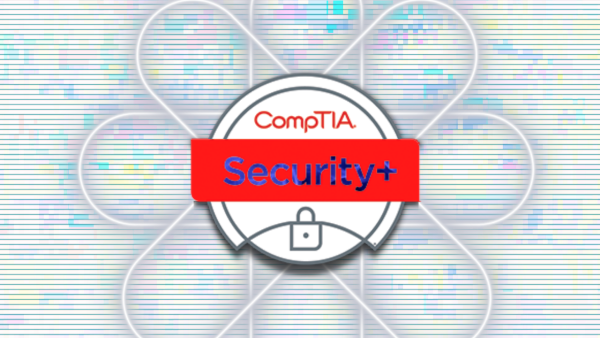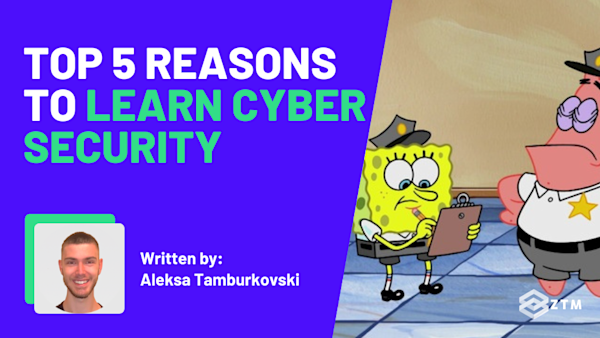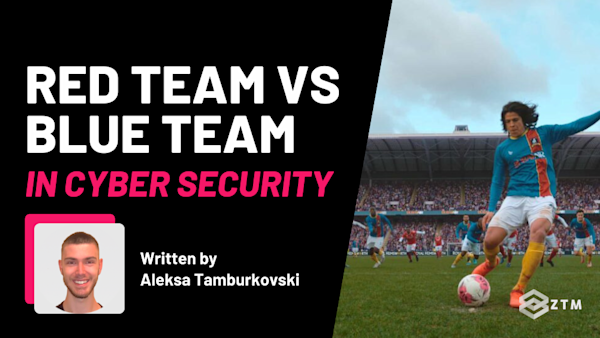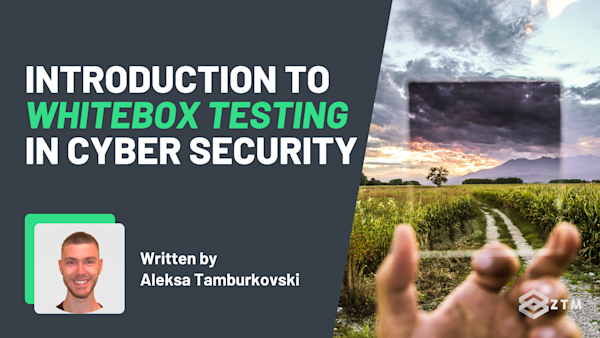Every byte of your data, from emails to bank logins, moves across networks that are constantly under attack.
Most of the time, you don’t even realize it until its too late. But when an attacker does get through, the damage is instant. Ransomware shuts down pipelines, personal data leaks onto the web, and information gets stolen.
So how does this keep happening? And more importantly, how do you stop it?
In this guide we’ll take a look at network security, how it works, and how hackers get through it. Because understanding how networks are breached is the first step toward securing them.
Sidenote: If you want to learn how to take your network security to the next level, then you need to learn how it's hacked in my Network Hacking + Security course:
This course takes your ethical hacking and penetration testing skills to the next level by diving deep into advanced network attacks, showing you how to bypass security measures, exploit vulnerabilities, and even craft your own network-based exploits. The best way to learn to defend, is to understand how the attacks work.
With that out of the way, let’s get into this guide…
What is network security?
At its core, network security is about control.
It decides:
Who can connect
What they can access
And how to detect anything suspicious before it becomes a full-blown breach. That includes blocking malicious traffic, encrypting sensitive data, isolating internal systems, and monitoring everything that moves across the wire
Why so thorough? Because it only takes one overlooked device to bring it all down.
For example
Back in 2018, attackers breached a casino’s corporate network through a smart fish tank thermometer.

The problem of course is that most internet connected ‘smart’ devices have poor cyber security, even in 2025. And all it takes is one weak device on a network, for them to get inside.
From there, they scanned systems, moved through the network, and quietly exfiltrated sensitive data from a backend database . All because one network-connected gadget had a vulnerability.
In all fairness though, the full blame can’t be just on this one device.
Why?
Because network security isn’t just how well you defend the initial attack. It’s also how secure your network is once they're in, and how much you can limit them from making it worse.
How network security works
Network security isn’t one tool or one setting. It’s a system of layered defenses — each one designed to either block threats from getting in, limit how far they can go, or detect them before they cause damage. And if one layer fails, the others are there to catch what slips through.
So let’s look at each layer and how they work, along with some common hacks and defensive options.
Layer #1. Perimeter controls
Every network needs a front line — something to decide who’s allowed in, what they can do, and who gets turned away. That’s what perimeter controls are for. Think of them like the locks on your building or the security at the front gate. Their job is to inspect every connection request and decide what gets through and what gets dropped.
This usually starts with firewalls. A firewall monitors the traffic entering and leaving your network. It might block unused ports, deny traffic from suspicious IP addresses, or reject connections that don’t follow expected patterns. Routers help too, forwarding traffic and enforcing rules based on where it came from, where it’s going, or what protocol it’s using.
Sounds straightforward. But here’s the problem. If that outer layer is misconfigured, attackers don’t have to break in. They just log in through the front door.
How it’s hacked
The majority of crimes are acts of opportunity. A wallet left on a table unattended. A car left unlocked with the keys inside. Etc.
It’s the same for cybersecurity. Attackers look for common opportunities and cross-reference them with known vulnerabilities and credentials.
For example
Sometimes it’s as simple as finding a forgotten test server or an open login page running outdated software. (Or a fish tank connected to the internet with zero security).
Then they look up known vulnerabilities using tools like Shodan, Censys, and Nmap to scan the internet and find known exposed services that they can access. Things like RDP, SSH, database ports, or admin dashboards with placeholder access still in place.
That’s how the Colonial Pipeline breach started.
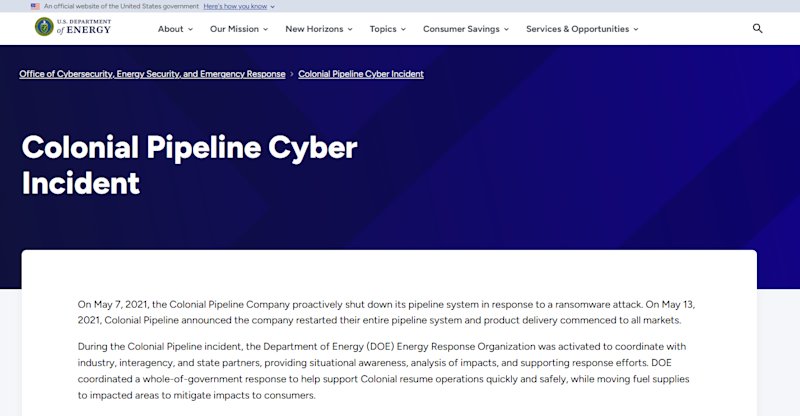
Hackers found one exposed VPN account, with no multi-factor authentication set up, and no rate limiting. Basically just a front door with no security standing in front of it.
Scary stuff huh?
How to defend it
As you can see, these aren’t theoretical risks. They’re the kind of vulnerabilities you learn about quickly once you start studying offensive security. And when you know what they’re looking for, you can stop leaving those opportunities lying around.
As for perimeter defense, the goal here isn’t to make the network invisible. It’s to make sure anything that is exposed is intentional, secured, and monitored.
That means:
Blocking any ports and services you don’t need
Never exposing login panels or admin tools directly to the internet
Using VPNs or zero-trust access for any remote connection
Requiring multi-factor authentication for everything external
Putting public-facing services in a DMZ so they can’t talk to sensitive internal systems
Regularly scanning your own network from the outside — using the same tools attackers use — to see what’s exposed before they do
Basically, thinking and acting like a hacker so you know where your weaknesses are.
Trust me on this - if you’ve never searched Shodan, or scanned your own systems with Nmap, you might be surprised what’s sitting out there. But once you’ve seen it from the other side, you’ll never look at your firewall the same way again.
So, assuming you’ve done all that, what’s next?
Well, perimeter controls are your first line of defense, but what if someone gets past it? What can you do then?
Layer #2. Access control
Access control decides what users can do once they’re on your network. This is obviously great for security reasons but it also helps make sure that the intern can’t access vital data and delete files by accident.
At its core, access control is about boundaries:
Can this account access sensitive systems?
Should this device talk to that server?
Does this user really need admin rights?
When it works, access control limits the blast radius of a breach. The problem of course is that we don’t always have good internal security habits…
How this layer gets attacked
The biggest issue is that most networks assume trust once you’re connected.
Take the casino fish tank breach. The thermometer had access to the main network and once the attackers got in through that IoT device, nothing stopped them from reaching a backend database.
That’s not unusual. Many internal networks operate on the assumption that “if it’s inside, it’s safe.” But attackers exploit this constantly.
Some common ways access controls break down:
Saved credentials. An attacker lands on a developer machine and pulls passwords stored in the browser or a config file
Credential reuse. A user’s leaked email and password from a third-party site is the same one they use for their work VPN or internal portal
Shared admin accounts. Once one user is compromised, those shared credentials unlock everything
Weak segmentation. Devices that don’t need to talk but can. Such as an in house marketing laptop that can for some reason communicate with a database server
So as you can see, more often than not, they don’t even need to exploit a flaw. A phishing link or a default password might be enough to get inside, and once they’re in, they pivot using whatever access that account already had.
How to defend it
Good access control means treating internal access as untrusted by default and only allowing what’s necessary.
Here’s what that looks like in practice:
Use role-based access control (RBAC) to give users only the permissions they need
Segment your network using VLANs or subnets so that internal systems are isolated from each other
Enforce MFA everywhere, not just on external logins
Regularly review permissions and revoke old or unused accounts
Use network ACLs to explicitly define what systems can talk to each other
A good rule of thumb is if a system doesn’t need to talk to another, don’t let it. If a user doesn’t need access, don’t grant it “just in case.”
The fewer paths attackers have to follow, the more chances you have to catch them or stop them in their tracks.
Even better? Is if they manage to get access but can’t do anything with what they find.
Layer #3. Encryption
One of the first things an attacker checks is whether your network traffic is encrypted, because if it isn’t, they can read everything.
For example
If someone logs into a site over plain HTTP, or transfers files using outdated protocols like FTP or Telnet, anyone on the same network can intercept and read that traffic in real time.
Even worse, they don’t need expensive gear to do it. With free tools like Wireshark, an attacker can capture usernames, passwords, session cookies, or even full documents as they move between systems.
Encryption protects that data while it’s in motion. Without it, anything that crosses the wire is fair game.
Modern networks rely on:
TLS/SSL to secure websites, emails, APIs, and file transfers
VPN tunnels to protect remote workers on untrusted networks
End-to-end encryption for apps and tools that pass sensitive data between users or systems
How this layer is attacked (+ how to defend it)
However, just having encryption in place isn’t enough. You also have to make sure it actually works , because one of the most common failures at this point is fallback.
For example
If a certificate is expired or misconfigured, many systems quietly downgrade to an unencrypted connection. That gives attackers a chance to intercept traffic or strip encryption entirely — especially during phishing or man-in-the-middle attacks. Tools like sslstrip are designed for this exact move.
To prevent it,make sure to enforce HTTPS across all services and apply HTTP Strict Transport Security (HSTS). That blocks fallback and forces browsers to keep encryption in place. You should also audit certificates regularly to catch issues like mismatched domains or weak configurations — especially on anything public-facing.
Legacy support and systems is another weak spot
If your systems still allow old protocols like SSLv2, TLS 1.0, or outdated cipher suites, attackers can force a downgrade and break encryption that way too. Disable them completely and test with tools like Qualys SSL Labs to find anything still slipping through.
And if you’re still running services like FTP, Telnet, or POP3? Those transmit everything in plain text. Even one legacy service can expose your entire environment. Replace them with secure alternatives, or shut them down completely.
Then there’s the human side
Many users click through certificate warnings without realizing the risk, and end up handing credentials to fake sites over HTTP without a second thought. That’s why it’s critical to enforce strict validation, monitor for unusual domains, and educate users on what certificate errors actually mean.
TL;DR
Attackers don’t need to break encryption. They just need to find where it’s missing, weak, or misconfigured. So real defense isn’t just turning encryption on. It’s making sure there are no quiet gaps where it disappears.
Let's be honest though - that can happen. Which is why the next layer is just as important to reduce the impact.
Layer #4. Monitoring
Once an attacker gets in, how long they stay and how much damage they can do will often depend on how quickly someone finds them, which is where monitoring tools come into effect.
They don’t block attacks directly, but they can give you a warning if something seems off.
So let me explain
The thing most people don’t realize is that attackers don’t usually move fast. They move quietly.
Rather than add malware to cause issues and bring attention to themselves, they use tools like PowerShell, WMI, certutil, scheduled tasks. All stuff that blends into what sysadmins might do to help disguise themselves, and so they can scan internal systems, escalate privileges, and set up long-term access.
They’ll also set up a command and control (C2) channel so they can manage the breach remotely. Sometimes that’s a simple reverse shell. But in real attacks, they’ll often use stealth C2 frameworks like:
Cobalt Strike (common in red team and ransomware ops)
Sliver (open-source and modular)
Mythic (customizable C2 with multiple agents)
Metasploit’s Meterpreter (used in targeted campaigns)
These tools encrypt their traffic, randomize their beacons, and communicate over allowed protocols like HTTPS or DNS.
How to defend it
Monitoring is all about connecting patterns that don’t belong and surfacing the signals that suggest something’s wrong.
To do that, you’ll want a mix of:
SIEMs (Security Information and Event Management) to correlate logs from firewalls, endpoints, servers, and cloud tools, along with alert on combinations that suggest an attack
NIDS (Network Intrusion Detection Systems) to scan network traffic for known attack signatures from port scans to beacon traffic
Anomaly detection that watches for deviations from your baseline, such as a dev laptop scanning internal systems, a scheduled task created at 3 a.m, and an outbound DNS queries to domains you've never seen before. Basically just sniff out things that don’t seem right
For example
Let’s say an attacker compromises a user’s laptop. They use BloodHound to map out the network, dump credentials with Mimikatz, and spin up a PowerShell script to pivot to another box.
The good news is that if you’ve set up monitoring for PowerShell abuse, unexpected lateral movement, or C2 check-ins, then that’s your window to act.
That being said - how you choose to act is important.
Layer #5. Incident response
This is the layer you hope you never need but the one you’ll be glad you have when things go wrong. Because no matter how many defenses you put in place, someone eventually slips through. And when they do, the clock starts ticking.
Incident response is what happens next. It’s the set of steps your team takes to contain the threat, investigate what happened, and stop it from getting worse.
The problem of course is that most teams focus so much on prevention that they forget about response. There’s no clear plan, no assigned roles, and no process for decision-making under pressure. So when something bad does happen such as ransomware getting triggered or credentials being leaked, people freeze. Or worse, they act too late.
Meanwhile, the attacker is still inside. Still moving. Still stealing data or laying traps.
How to defend it
Strong incident response doesn’t mean stopping every attack instantly. It means knowing how to act fast, stay calm, and make smart decisions under fire. And that only happens if you’ve already prepared.
That includes:
Knowing how to isolate affected systems quickly before the attacker spreads
Having visibility into which accounts and data were accessed
Resetting passwords and revoking session tokens or API keys
Patching the initial exploit vector so it can’t be used again
Rebuilding compromised systems from clean backups
Documenting the timeline, actions taken, and notifying stakeholders or regulators when required
And depending on your industry - informing authorities and government agencies that the breach has happened ASAP
For example
Let’s say monitoring catches outbound traffic from a server that shouldn’t be making any. You isolate it immediately and find a scheduled task uploading zip files to Dropbox. That’s exfiltration in progress.
Without a response plan, you might hesitate or overlook what data was taken. But with a plan? You know what to shut down, what logs to pull, and who needs to know right now.
It isn’t just about stopping attackers. It’s about keeping control when things fall apart!
Network security isn’t optional anymore
So as you can see, whether it’s a single exposed port or a misconfigured access rule, one small gap is all it takes to bring everything down.
That’s why security can’t be an afterthought. It has to be intentional, layered, and constantly evolving — because hoping nothing breaks isn’t a strategy! It’s just wishful thinking.
If you’re serious about protecting your systems, the time to build real defenses isn’t later.
It’s now.
P.S.
Remember, if you want to learn how to fully defend your network, then you need to learn how hackers attack them.
So check out my Network Security + Hacking course to learn more.
Take your ethical hacking skills to the next level by learning network hacking techniques, from Man In The Middle and DNS spoofing to router exploits and custom payload creation.
You’ll learn to master real-world attack methods, bypass security measures, and gain the skills needed for penetration testing and cybersecurity roles. Because the best defence understands the offence!
Better still?
If you join ZTM as a member, then you’ll get access to each of my cyber security courses, as well as access to our private Discord server.
Here you can chat to me, other students, and working cybersecurity professionals and get help with any questions you might have 24/7.
It’s the best investment you can make to improve your cyber security in 2025.
Want more Cyber Security content?
If you enjoyed this post, then check out my other guides and tutorials!
Best articles. Best resources. Only for ZTM subscribers.
If you enjoyed Aleksa's post and want to get more like it in the future, subscribe below. By joining over 500,000 ZTM email subscribers, you'll receive exclusive ZTM posts, opportunities, and offers.
No spam ever, unsubscribe anytime



